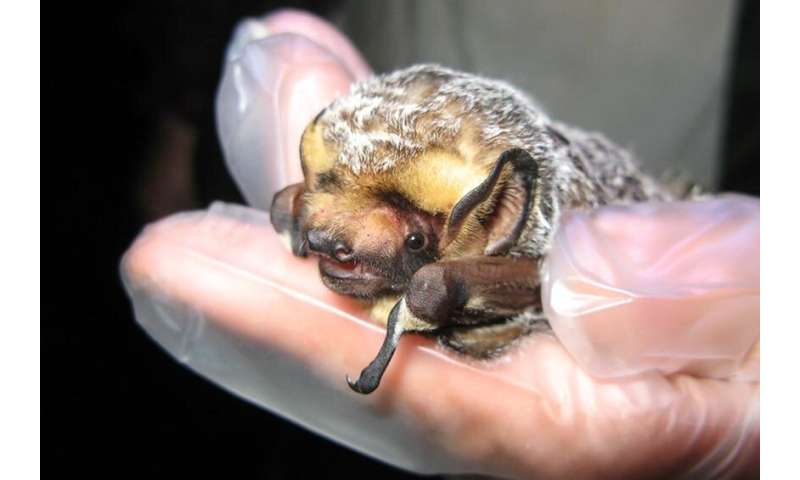WIND TURBINES
Monitoring, deterrence and curtailment make skies safer for bats

The German word for bat is Fledermaus, which translates literally to "flutter mouse." But while some bats do look like mice fluttering on leathery wings, bats are more closely related to humans than rodents. And, as NREL reported last year, bats are amazing. Whether they are providing pest control by hunting mosquitoes, pollinating flowers by drinking nectar, or dispersing seeds by eating fruit, bats are vital to the health of our planet.
Yet these beneficial mammals face many threats, including the wind turbines that occupy their airspace. Tree-roosting species like the hoary bat, eastern red bat, and silver-haired bat account for the most activity around wind turbines, and endangered species like the Hawaiian hoary bat and Indiana myotis are at risk as well. Complicating matters, bats seem to be attracted to wind turbines.
Bats are notoriously difficult to study, and there is still much we do not know about them. To help improve understanding of bats and their behavior around wind turbines, NREL is collaborating on several research and development projects funded by the U.S. Department of Energy Wind Energy Technologies Office. These efforts are helping minimize wind turbine-bat encounters through monitoring, deterrence, and curtailment.
Deterring Bats with Ultrasound Devices
Ultrasound has proven an effective deterrent for some species at wind sites, but additional research is needed to improve ultrasound's success in discouraging more bats from approaching the turbines.
NREL is involved with two projects focused on ultrasound bat deterrents. The laboratory is leading a project that uses thermal video and acoustic detectors to record the behavior of bats inside an "open-air" flight cage with acoustic deterrent devices mounted on either end. With the data gained from observing bats' behavior around these devices, the team hopes to better understand the frequency range needed to effectively deter bats from approaching turbines.
NREL is also collaborating with Midé Technology to develop a self-powered, blade-mounted ultrasound deterrent.
"The device operates according to the same basic fluid dynamic principle as a hydroelectric generator," said NREL researcher Jason Roadman. "Air moves through the device as it rotates on the turbine blade, which generates the power the device needs to generate the acoustic deterrent."
This design puts the deterrent device directly on the turbine blade, repelling bats from the point they need to avoid most and minimizing the effect of the ultrasonic noise dissipating with distance.
Monitoring Bat Behavior with Thermal Imaging
Thermal imaging is a useful tool for monitoring bats and other airborne wildlife at wind sites, as it can help researchers develop deterrent and curtailment systems and determine how well existing systems are working.
NREL is supporting two projects focused on thermal monitoring technology. In collaboration with the University of Colorado at Colorado Springs and Bat Conservation International, NREL is supporting the advancement of 3-D video analysis to capture tracks of flying targets and developing an accompanying software package. The software is currently in a beta testing phase and will be published, along with the underlying code, later this year.
In addition, NREL is working with the United States Geological Survey to improve thermal imaging target detection and classification with the development of binary and multi-class machine learning algorithms in an open-source language, which will be published in the coming months.
"Thermal video shows the most promise in helping us understand how bats interact with turbines," said NREL researcher Bethany Straw. "Then we can focus research and development on using what we know about bat behavior to inform more effective solutions."
Curtailing Turbines with Real-Time Data
Curtailed turbine blades move slowly when wildlife is likely to be present, allowing species to more easily navigate around the blades. However, this strategy has a few drawbacks.
"Curtailment may not be effective for all species, results in a loss of power generation, and can be cost-prohibitive, particularly in relatively low wind regions," said NREL Researcher Cris Hein. "This means we need smart curtailment methods, which use additional variables to limit curtailment to the highest periods of risk."
NREL is working with the Electric Power Research Institute and Natural Power, an independent renewable energy consulting company, to develop the Turbine-Integrated Mortality Reduction (TIMR) system and the Bat Smart Curtailment (BSC) system, respectively. These technologies use real-time data on bat presence and wind speed to determine whether a turbine should be curtailed. Once completed, these systems will reduce both impacts on bats and unnecessary curtailment while reducing loss in annual energy production.
Right now, it is more important than ever that we learn about and protect these often misunderstood creatures. Through these efforts, NREL researchers are finding innovative solutions for making the skies safer so bats can do what they do best: eat bugs, pollinate flowers, scatter seeds, and keep our planet healthy.
No comments:
Post a Comment